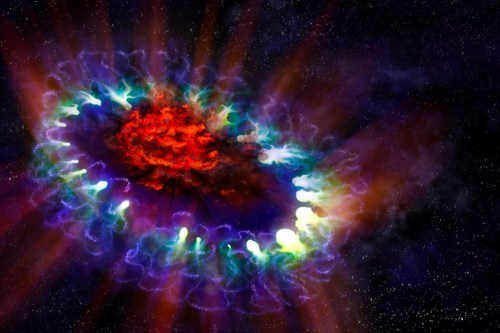
The first recorded observation of a supernova dates all the way back to 185 AD, but it wasn’t until recently that scientists have been able to map what occurs at the core of these explosions. Now, thanks to computer models of a supernova first witnessed 30 years ago, astronomers at National Radio Astronomy Observatory (NRAO) have been able to depict the inside of this event.
“Supernovae explosions involve a lot of physics under extreme conditions,” Remy Indebetouw, an astronomer at the University of Virginia and NRAO, told Digital Trend. “Vast quantities of neutrinos; nuclear fusion and rapid decay; fluid and plasma dynamics and instabilities. It has been a great challenge to model them, and for many years astronomers had difficulties getting stars to explode at all in computer simulations.”
Although supernovae are relatively common within our observable universe, they still only occur every 50 years on average in galaxies as big as the Milky Way. That means scientists don’t often get the chance to study such an event from the initial explosion to its end, when it cools down and new molecules begin to form.
Indebetouw and his team used data from Chile’s Atacama Large Millimeter Array (ALMA) to study a supernova named SN 1987A, which occurred within a dwarf galaxy some 163,000 light-years away. Collected and analyzed over three decades, the ALMA data gave unprecedented detail about the star’s violent death, including the emergence of elements like carbon, oxygen, and nitrogen, and the formation of molecules like silicon monoxide (SiO) and carbon monoxide (CO).
“Supernovae are rare but very energetic, and disrupt vast parts of space around them,” Indebetouw said. “They are the source of most of the atoms like carbon and oxygen that eventually form planets and people, and astronomers have evidence that a supernova exploded near enough to our own solar system that some of the material from that explosion forms part of Earth. It’s really important to understand how, when, and where supernovae go off to understand how, when, and where stars, planets, and life forms in galaxies.”
Though scientists had previously estimated how and where molecules would combine within supernovae, this marks the first time data was captured in resolution high enough to confirm the test models. Two papers detailing the research have been published in the journals Astrophysical Journal Letters and Monthly Notices of the Royal Astronomical Society.
Editors' Recommendations
- 3D printed cheesecake? Inside the culinary quest to make a Star Trek food replicator
- Hubble captures the site of an epic supernova, spotted by amateur astronomers
- The future of making stuff: Inside the evolution of 3D printing with Formlabs
- Urine luck: Astronauts’ pee could be the secret ingredient to future moon bases
- How tech has impacted archaeologists’ hunt for long-lost civilizations